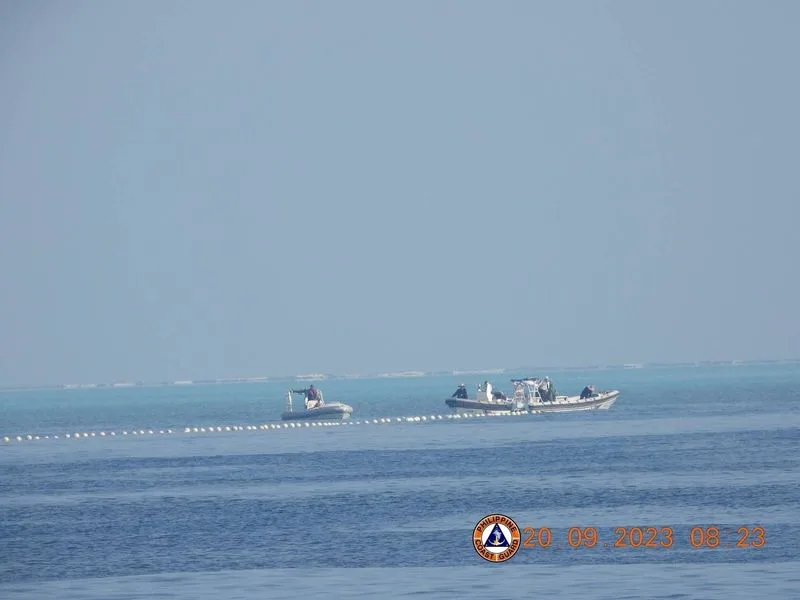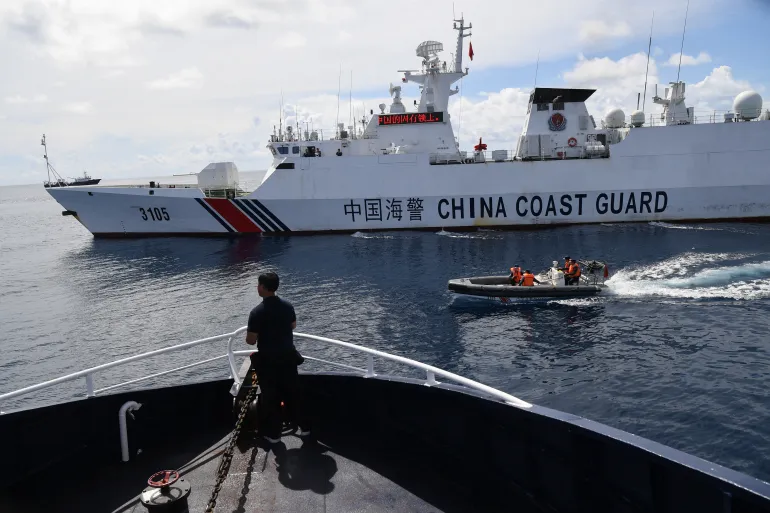Philippines Removes Chinese Barrier In South China Sea
In a recent development in the ongoing tensions in the South China Sea, Philippines removes Chinese barrier in South China Sea. The Philippines has executed a "special operation" to remove a floating barrier installed by China.
Author:Suleman ShahReviewer:Han JuSep 27, 2023687 Shares36.1K Views

In a recent development in the ongoing tensions in the South China Sea, Philippines removes Chinese barrier in South China Sea. The Philippines has executed a "special operation" to remove a floating barrier installed by China.
The Philippines Coast Guard carried out this operation following instructions from President Ferdinand Marcos Junior.
This move has raised concerns and could potentially escalate tensions in one of Asia's most disputed regions.
Violation Of Fishing Rights
Manila has accused China of violating its fishing rights by erecting a 300-meter (1,000-foot) barrier near the Scarborough Shoal, a rocky outcrop located approximately 200 km (124 miles) from the Philippines.
This area has been a source of intermittent conflicts over sovereignty and fishing rights between the two nations.
China, which claims more than 90% of the South China Sea, seized control of the Scarborough Shoal in 2012.
Beijing's coastguard defended the installation of the barrier, referring to it as "necessary measures." However, this action has been strongly condemned by the Philippines and is viewed as a violation of international law.
The Philippines Coast Guard, in a statement, argued that the barrier posed a hazard to navigation and was a clear violation of international law.
“„They might still return the floating barrier once again, they might still do shadowing and dangerous maneouvres once again.- Philippine coastguard spokesperson Commodore Jay Tarriela
Additionally, it hindered the livelihood activities of Filipino fishermen who rely on the Scarborough Shoal for their fishing needs. The Philippines has also asserted that the shoal is an integral part of its national territory.
“„We have shown the world the Filipino people will not back down and we're still going to consistently carry out whatever is necessary for us to maintain our presence.- Philippine coastguard spokesperson Commodore Jay Tarriela

Historical Context
Under the leadership of former President Rodrigo Duterte, the Philippines and China have maintained a relatively peaceful coexistence in the Scarborough Shoal since 2017.
This period saw Filipino and Chinese fishermen sharing the area's resources, including the rich fishing grounds and the sanctuary it provides during storms.
However, tensions have escalated since President Ferdinand Marcos Junior came to power. His government has been strengthening military ties with the United States, a move that has strained relations with Beijing.
The Scarborough Shoal's strategic significance and its historical association with a legal case filed by the Philippines at the Permanent Court of Arbitration in The Hague add complexity to the situation.
Implications For Regional Stability
This recent development underscores the volatile nature of the South China Sea dispute and its potential to impact regional stability.
Japan has urged calm in the region, emphasizing that the South China Sea is central to regional stability.
As the Philippines takes measures to assert its sovereignty and protect its fishermen's livelihoods, the situation in the South China Sea remains unpredictable.
China's territorial claims and actions in this region continue to be a source of tension, not only with the Philippines but also with neighboring countries and the international community.
The removal of the barrier is just one chapter in a long-standing and complex dispute that shows no signs of resolution in the near future.
Final Words
The Philippines' removal of a Chinese barrier near the Scarborough Shoal in the South China Sea highlights the ongoing tensions in this disputed region.
This move, undertaken at the instruction of President Ferdinand Marcos Junior, has raised concerns about potential escalation and its impact on regional stability.
The dispute involves claims to fishing rights, sovereignty, and international law violations, with China defending its actions as necessary measures.
The situation underscores the volatility of the South China Sea dispute, with an uncertain future and no immediate resolution in sight.

Suleman Shah
Author
Suleman Shah is a researcher and freelance writer. As a researcher, he has worked with MNS University of Agriculture, Multan (Pakistan) and Texas A & M University (USA). He regularly writes science articles and blogs for science news website immersse.com and open access publishers OA Publishing London and Scientific Times. He loves to keep himself updated on scientific developments and convert these developments into everyday language to update the readers about the developments in the scientific era. His primary research focus is Plant sciences, and he contributed to this field by publishing his research in scientific journals and presenting his work at many Conferences.
Shah graduated from the University of Agriculture Faisalabad (Pakistan) and started his professional carrier with Jaffer Agro Services and later with the Agriculture Department of the Government of Pakistan. His research interest compelled and attracted him to proceed with his carrier in Plant sciences research. So, he started his Ph.D. in Soil Science at MNS University of Agriculture Multan (Pakistan). Later, he started working as a visiting scholar with Texas A&M University (USA).
Shah’s experience with big Open Excess publishers like Springers, Frontiers, MDPI, etc., testified to his belief in Open Access as a barrier-removing mechanism between researchers and the readers of their research. Shah believes that Open Access is revolutionizing the publication process and benefitting research in all fields.

Han Ju
Reviewer
Hello! I'm Han Ju, the heart behind World Wide Journals. My life is a unique tapestry woven from the threads of news, spirituality, and science, enriched by melodies from my guitar. Raised amidst tales of the ancient and the arcane, I developed a keen eye for the stories that truly matter. Through my work, I seek to bridge the seen with the unseen, marrying the rigor of science with the depth of spirituality.
Each article at World Wide Journals is a piece of this ongoing quest, blending analysis with personal reflection. Whether exploring quantum frontiers or strumming chords under the stars, my aim is to inspire and provoke thought, inviting you into a world where every discovery is a note in the grand symphony of existence.
Welcome aboard this journey of insight and exploration, where curiosity leads and music guides.
Latest Articles
Popular Articles